
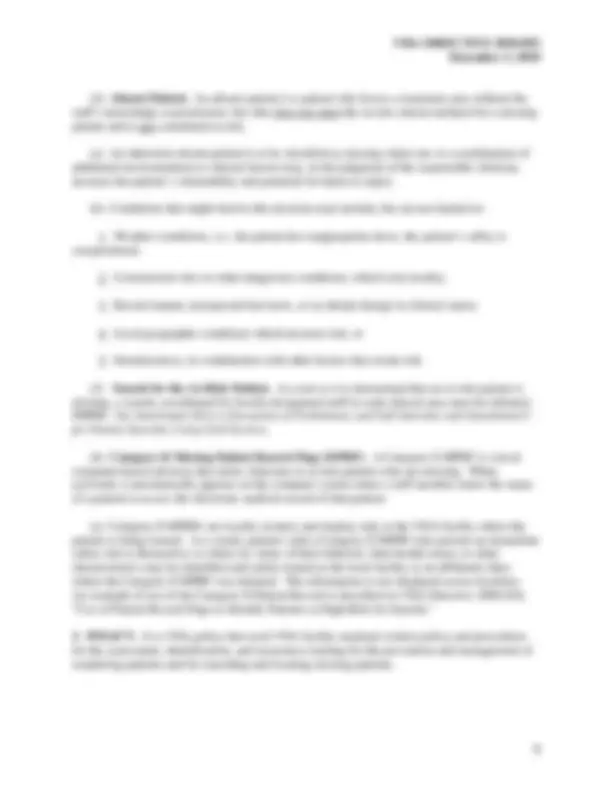
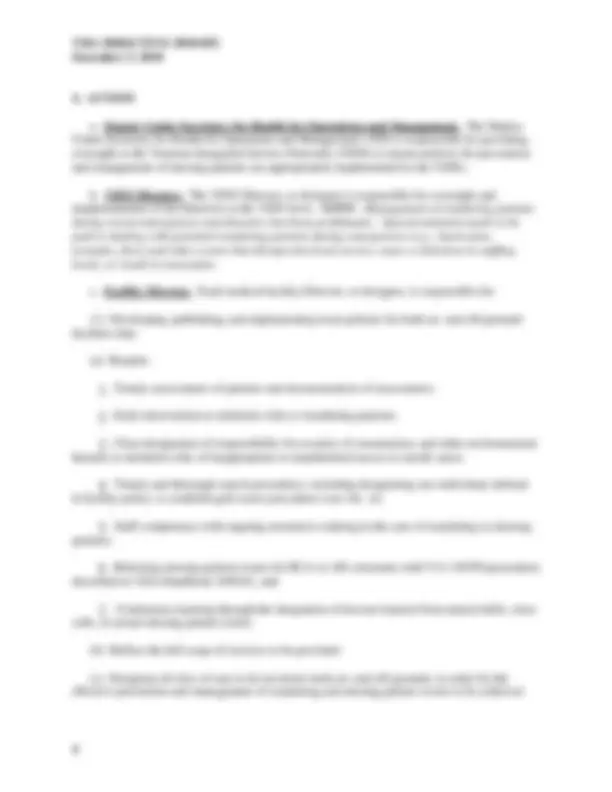
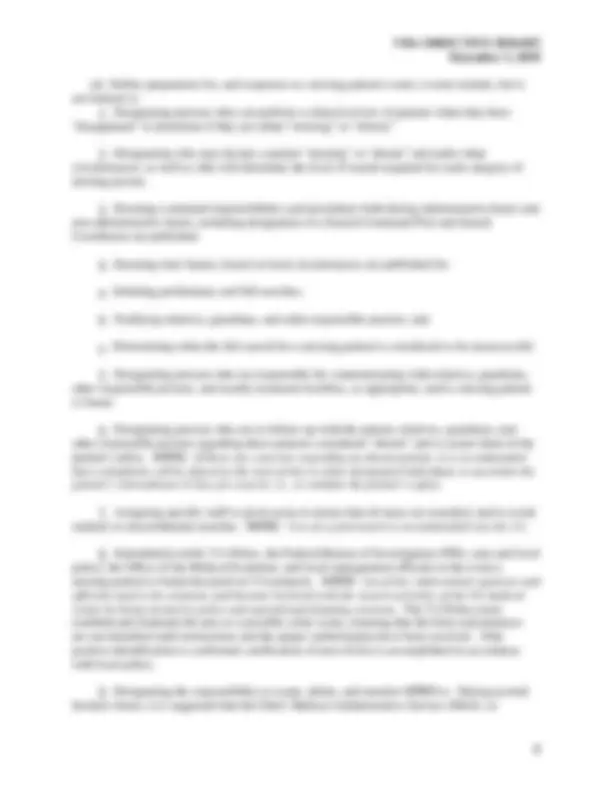
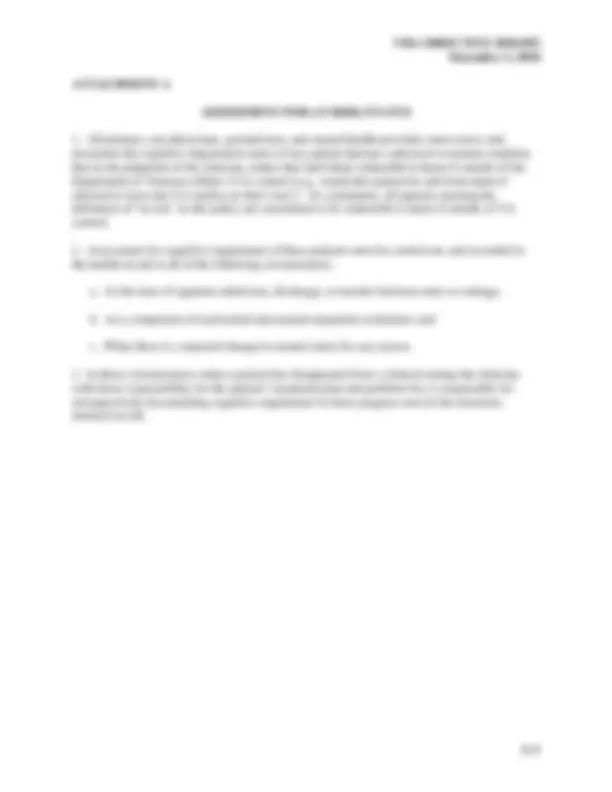
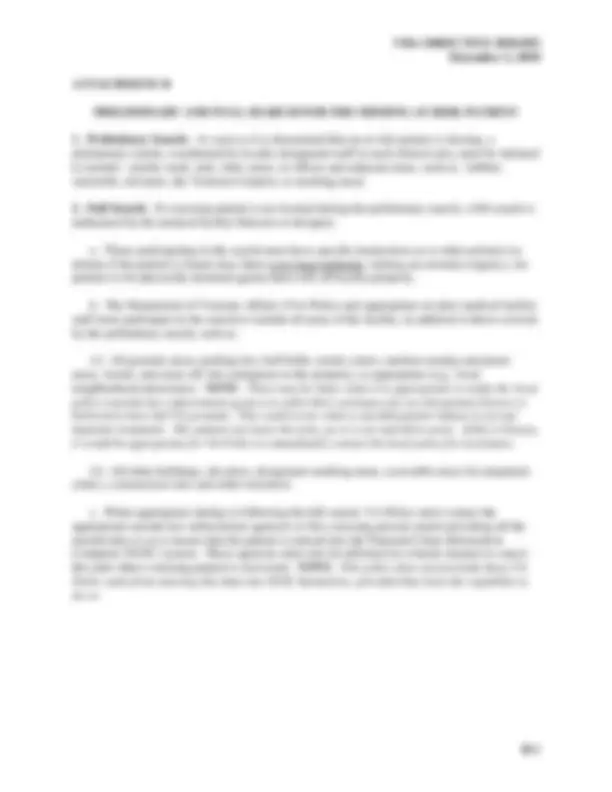
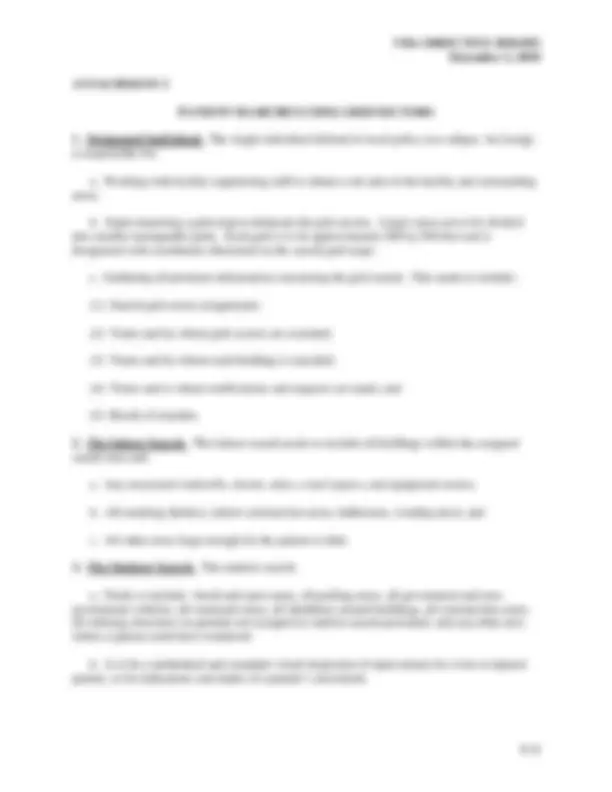
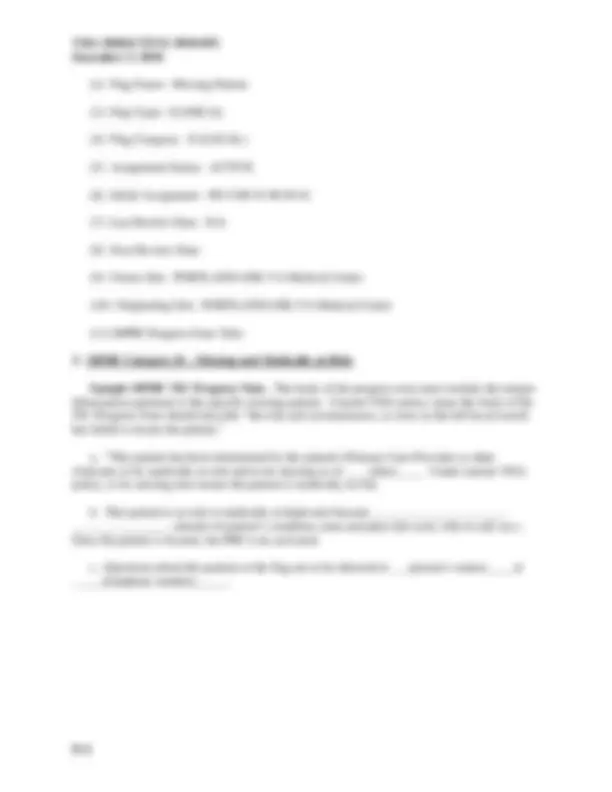
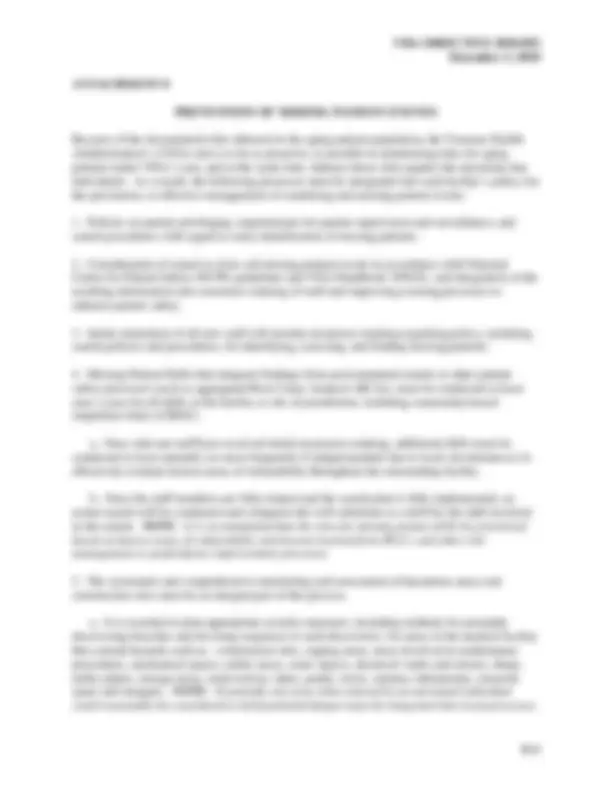
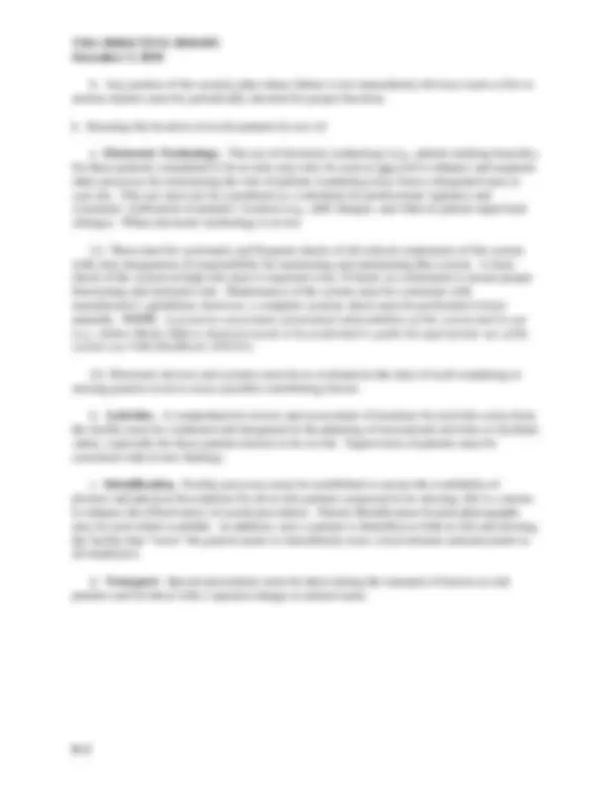


Study with the several resources on Docsity

Earn points by helping other students or get them with a premium plan


Prepare for your exams
Study with the several resources on Docsity

Earn points to download
Earn points by helping other students or get them with a premium plan
Community
Ask the community for help and clear up your study doubts
Discover the best universities in your country according to Docsity users
Free resources
Download our free guides on studying techniques, anxiety management strategies, and thesis advice from Docsity tutors
Special attention needs to be paid to dealing with potential wandering patients during emergencies (e.g., hurricanes, tornados, fires) and other ...
Typology: Exercises
1 / 15

This page cannot be seen from the preview
Don't miss anything!










Department of Veterans Affairs VHA DIRECTIVE 2010- 052 Veterans Health Administration Washington, DC 20420 December 3, 2010
MANAGEMENT OF WANDERING AND MISSING PATIENTS
1. PURPOSE: This Veterans Health Administration (VHA) Directive establishes policy to ensure that each Department of Veterans Affairs’ (VA) medical facility has an effective and reliable plan to prevent, and effectively manage wandering and missing patient events that place patients at-risk for harm. NOTE: This policy is applicable to all sites and levels of care including: hospital and VA Community Living Centers; domiciliary and residential bed care facilities (mental health residential rehabilitation and treatment programs); VA-owned or leased off-ground health care facilities; day centers; day hospitals; day treatment centers; Psychosocial Rehabilitation and Recovery Programs (PRRC); community-based outpatient clinics (CBOC); Independent Outpatient Clinics; and Outreach Clinics. 2. BACKGROUND
a. In VHA facilities, patients straying beyond the normal view or control of employees may be at-risk for injury or death. Although VHA has responsibility for all patients under its care, physically, mentally, or cognitively-impaired patients require a distinctly higher degree of monitoring and protection.
b. Although the Missing Patients Register no longer exists, missing patients continue to be tracked as Issue Briefs, which facility Directors submit to the Office of the Deputy Under Secretary for Health for Operations and Management (10N).
c. To prevent accidental deaths and injuries to wandering and missing patients, VHA must:
(1) Recognize, specify, and maintain appropriate staff responsibility for the whereabouts of patients;
(2) Systematically assess all patients to determine the risk potential for those who may wander or become missing from a treatment setting;
(3) Detect missing patients early; and
(4) Initiate prompt search procedures.
d. The National Center for Patient Safety (NCPS) reviews Root Cause Analysis (RCA) investigations and Aggregate Reviews (AR) involving missing patients that are submitted to NCPS, and disseminates relevant information to VHA facilities to foster the reduction and elimination of risks. NOTE: This information is communicated in numerous ways, including advisories, alerts, newsletters, and national calls. Examples: Topics in Patient Safety newsletter http://vaww.ncps.med.va.gov/Publications/TIPS/Docs/TIPS_NovDec05.pdf#page=1 and NCPS Report http://vaww.ncps.med.va.gov/Initiatives/RCATopics/docs/Secure_Unit_Elopement.pdf. These are internal websites and are not available to the public.
December 3, 2010
e. Definitions
(1) The At-Risk Patient. The essential question in determining if a patient is at-risk when they have wandered or gone missing is whether they are at-risk for harm to themselves or others if not found and returned to a safe treatment environment. A patient’s cognitive ability, the ability to make rational decisions, is a major feature of the assessment of risk in such situations. NOTE: A more detailed discussion of the “at-risk” assessment is found in Attachment A. Patients are considered at-risk if, at a minimum, they:
(a) Are legally committed;
(b) Have a court-appointed legal guardian;
(c) Are considered dangerous to self or others;
(d) Are gravely disabled due to a mental disorder;
(e) Lack cognitive ability (either permanently or temporarily) to make relevant decisions; or
(f) Have physical limitations that increase their risk.
(2) Wandering Patient. A wandering patient is an at-risk patient who has shown a propensity to stray beyond the view or control of employees, thereby requiring a high degree of monitoring and protection to ensure the patient’s safety.
(3) Missing Patient. A missing patient is an at-risk patient who disappears from the patient care areas (on VA property), or while under control of VHA, such as during transport. Examples of situations when patients who meet the preceding criteria, and need to be considered missing include, but are not limited to the following:
(a) An inpatient or day treatment at-risk patient not present to receive a scheduled medication, treatment, meal, or appointment, and whose whereabouts are unknown.
(b) An at-risk patient checked in for an outpatient clinic appointment who is not present for the appointment when called, and whose whereabouts are unknown.
(c) An at-risk outpatient from a community facility (e.g., personal care residence, community nursing home) who does not return to the community facility following the appointment, and whose whereabouts are unknown.
(d) An at-risk patient who is using VHA-sponsored transportation (e.g., Disabled American Veterans vans, VHA drivers, VHA shuttles) who does not report to that transportation for the return trip, and whose whereabouts are unknown.
(e) An at-risk patient who does not return from pass as scheduled, and whose whereabouts are unknown.
December 3, 2010
a. Deputy Under Secretary for Health for Operations and Management. The Deputy Under Secretary for Health for Operations and Management (10N) is responsible for providing oversight to the Veterans Integrated Service Networks (VISN) to ensure policies for prevention and management of missing patients are appropriately implemented by the VISNs.
b. VISN Director. The VISN Director, or designee is responsible for oversight and implementation of the Directive at the VISN level. NOTE: Management of wandering patients during recent emergencies and disasters has been problematic. Special attention needs to be paid to dealing with potential wandering patients during emergencies (e.g., hurricanes, tornados, fires) and other events that disrupt electrical service, cause a reduction in staffing levels, or result in evacuation.
c. Facility Director. Each medical facility Director, or designee, is responsible for:
(1) Developing, publishing, and implementing local policies for both on- and off-grounds facilities that:
(a) Require:
(b) Reflect the full scope of services to be provided.
(c) Designate all sites of care to be involved, both on- and off-grounds, in order for the effective prevention and management of wandering and missing patient events to be achieved.
December 3, 2010
(d) Define preparation for, and responses to, missing patient events; it must include, but is not limited to:
a. Initiating preliminary and full searches;
b. Notifying relatives, guardians, and other responsible persons; and
c. Determining when the full search for a missing patient is considered to be unsuccessful.
December 3, 2010
c. Veterans Affairs Opinion General. Counsel Prec 37-91 (1991).
d. VHA Directive 2008-036, “Use of Patient Record Flags to Identify Patients at High Risk for Suicide.”
e. VHA Handbook 1050.01.
6. FOLLOW-UP RESPONSIBILITY: Office of Mental Health Services (116) is responsible for the content of this Directive. Questions may be referred to (202) 461-7349. 7. RESCISSIONS: VHA Directive 2008-057 is rescinded. This VHA Directive expires December 31, 2015.
Robert A. Petzel, M.D. Under Secretary for Health
Attachments
DISTRIBUTION: E-mailed to the VHA Publications Distribution List 12/8/
December 3, 2010
a. At the time of inpatient admission, discharge, or transfer between units or settings;
b. As a component of each initial and annual outpatient evaluation; and
c. When there is a reported change in mental status for any reason.
December 3, 2010
1. Designated Individual. The single individual defined in local policy (see subpar. 4c(1)(a)4) is responsible for:
a. Working with facility engineering staff to obtain a site plot of the facility and surrounding areas.
b. Super-imposing a grid map to delineate the grid sectors. Larger areas are to be divided into smaller manageable grids. Each grid is to be approximately 500 by 500 feet and is designated with coordinates illustrated on the search grid maps.
c. Gathering all pertinent information concerning the grid search. This needs to include:
(1) Search grid sector assignments;
(2) Times and by whom grid sectors are searched;
(3) Times and by whom each building is searched;
(4) Times and to whom notifications and requests are made; and
(5) Result of searches.
2. The Indoor Search. The indoor search needs to include all buildings within the assigned search area and:
a. Any unsecured stairwells, closets, attics, crawl spaces, and equipment rooms;
b. All smoking shelters, indoor construction areas, bathrooms, vending areas; and
c. All other areas large enough for the patient to hide.
3. The Outdoor Search. The outdoor search:
a. Needs to include: brush and open areas, all parking areas, all government and non- government vehicles, all courtyard areas, all shrubbery around buildings, all construction areas, all outlying structures on grounds not assigned to interior search personnel, and any other area where a patient could have wandered.
b. Is to be a methodical and complete visual inspection of open terrain for a lost or injured patient, or for indications and marks of a patient’s movement.
December 3, 2010
4. Search Team
a. Each search team is assigned to a grid or number of grids. Each grid is to be searched from south to north by a search team. Search team members are to be spaced abreast and sweep by lines. Several sweeps may be necessary to completely cover assigned grids. A designated team leader directs the search team.
b. The team leader is responsible for the safety of all team members, and for ensuring the search is completed. Failure to check one small area may result in a failed search.
c. If the patient is found, the search team renders first aid if needed, and notifies the command post of the location, and if needed, requests medical personnel be sent. If the patient is unharmed, the search team transports the patient back to the appropriate treatment area.
5. Patient Is Found Deceased. If the patient is found deceased, the patient and surrounding area must be cordoned off and preserved as a possible crime scene until instructions and the proper authorization has been received.
December 3, 2010
(2) Flag Name: Missing Patient
(3) Flag Type: CLINICAL
(4) Flag Category: II (LOCAL)
(5) Assignment Status: ACTIVE
(6) Initial Assignment: 08/11/08 @ 08:30:
(7) Last Review Date: N/A
(8) Next Review Date:
(9) Owner Site: PORTLAND (OR) VA Medical Center
(10) Originating Site: PORTLAND (OR) VA Medical Center
(11) MPRF Progress Note Title:
3. MPRF Category II – Missing and Medically at-Risk
Sample MPRF TIU Progress Note. The body of the progress note must include the unique information pertinent to the specific missing patient. Current VHA policy states the body of the TIU Progress Note should describe “the risk and circumstances, as soon as the full local search has failed to locate the patient.”
a. “This patient has been determined by the patient's Primary Care Provider or other clinicians to be medically at-risk and to be missing as of ____(date)____. Under current VHA policy, to be missing also means the patient is medically at-risk.
b. This patient is at-risk or medically at-high-risk because ______________________ _________________(details of patient’s condition, time and place last seen, who to call, etc.) Once the patient is located, the PRF is de-activated.
c. Questions about this patient or the flag are to be directed to ___(person’s name)____ at _____(telephone number)_____.
December 3, 2010
Because of the documented risks inherent in the aging patient population, the Veterans Health Administration’s (VHA) aim is to be as proactive as possible in minimizing risks for aging patients under VHA’s care, and at the same time, balance those risks against the autonomy due individuals. As a result, the following processes must be integrated into each facility’s policy for the prevention, or effective management of wandering and missing patient events:
a. Once relevant staff have received initial awareness training, additional drills must be conducted at least annually (or more frequently if judged prudent due to local circumstances) to effectively evaluate known areas of vulnerability throughout the surrounding facility.
b. Once the staff members are fully trained and the search plan is fully implemented, an actual search will be conducted and critiqued; this will substitute as a drill for the shift involved in the search. NOTE: It is recommended that the sites for missing patient drills be prioritized based on known areas of vulnerability and lessons learned from RCA’s and other risk management or performance improvement processes.
a. It is essential to plan appropriate security measures, including methods for promptly discovering breaches and devising responses to such discoveries, for areas of the medical facility that contain hazards such as: construction sites, staging areas, areas involved in maintenance procedures, mechanical spaces, utility areas, crawl spaces, electrical vaults and closets, shops, utility plants, storage areas, water towers, lakes, ponds, rivers, streams, laboratories, research space and morgues_._ NOTE: Essentially any area when entered by an untrained individual could reasonably be considered to hold potential danger must be integrated into local processes.